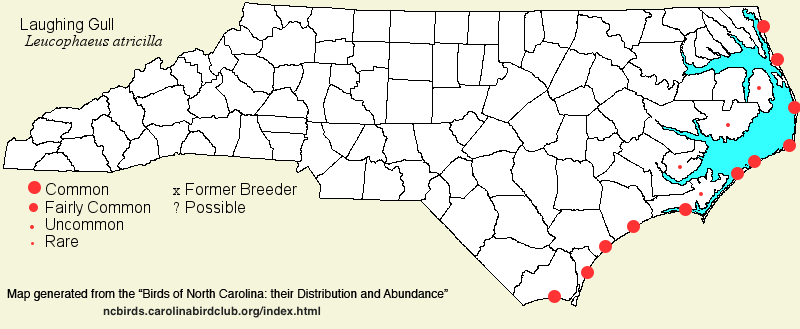 |  |
|
Laughing Gull - Leucophaeus atricilla LARIDAE Members: | Search Common: Search Scientific: |
|
|
|||||||
| General Comments | Historically, the Laughing Gull was North Carolina's only breeding gull species; however, in recent decades it has been joined by the larger and more "aggressive" Herring and Great Black-backed gulls as breeders, all in coastal areas. Nonetheless, thousands of Laughing Gulls nest in North Carolina, and it is certainly one of the most familiar and often seen birds along the coast for most of the year. Unlike the other two gulls, Laughings tend to depart the state in the depths of winter, though most coastal CBC's (which are held in early winter) record the species. Laughing Gulls almost always nest on small islands, both on natural estuarine islands and man-made dredge islands; nests, in dense colonies, are usually hidden in grasses, as opposed to exposed on bare sand. They forage over the inshore ocean, as well as in sounds and inlets; they can be seen resting at fresh to brackish ponds along the coast, but most foraging is at nearby salt water. Though the species does not nest in the interior of the continent, Laughings are not overly unusual on inland lakes, as birds nesting in the Northern coastal states either migrate routinely over the inner portions of the Southeast, or some birds are carried inland by storms in migration. Far inland birds are seldom seen away from large reservoirs, but near the coast, such as in the Tidewater zone, large numbers can be seen foraging in recently plowed fields. | ||||||
| Breeding Status | Breeder | ||||||
| NC BRC List | Definitive | ||||||
| State Status | |||||||
| U.S. Status | |||||||
| State Rank | S4B | ||||||
| Global Rank | G5 | ||||||
| Coastal Plain | Breeding summer resident and migrant, and early winter resident. Coastally, very common to abundant along the entire coast as a breeder and migrant, nesting in 10-15 colonies annually. In winter -- uncommon through Dec along the northern coast, fairly common but erratic along the central coast through Dec, and often common along the southern coast through Dec. However, by late Jan and early Feb, the species is usually rare along the coast, but northbound birds begin arriving by late in Feb. In mild winters, small numbers can be found in midwinter, but in severe winters, the species tends to be absent for a few weeks. In Tidewater, often common in summer and fall, into early Dec, but not breeding; does not overwinter in the region. Farther inland, mostly a rare to uncommon and local transient, with a preponderance of records from the Goldsboro area; mainly early Apr to late May, and late Aug to late Dec. Peak counts: 250,000, along Bogue Banks, 9-10 Dec 1981; 15,000, Morehead City CBC, 21 Dec 1983. Peak counts well inland: 80, near Tarboro (Edgecombe), 29 Nov 2013; 68, at Buckhorn Reservoir (Wilson) following the passage of Tropical Storm Ana, 11 May 2015. | ||||||
| Piedmont | Transient, at larger reservoirs. Generally rare in spring and in fall migrations, at times locally uncommon in fall (such as after storms/hurricanes), sparingly into early winter. Normal dates are mid-Apr to mid-May, and late Aug to early Dec, the latest being 4 Jan. No records from early Jan to mid-Feb. Peak counts: 285, Shelby, 22 Sep 1989 (after Hurricane Hugo); 232, Jordan Lake, 6-7 Sep 1996 (after Hurricane Fran). Spring peak: 21, Lake Crabtree (Wake), 6 May 2013; 12, Harris Lake (Wake), 11 Jun 2023. | ||||||
| Mountains | Transient. Very rare during spring (12 records) and fall (mostly after storms/ hurricanes), essentially at low elevations in the Henderson, Transylvania, Buncombe, and Haywood region. One was at a fairly high elevation at Blowing Rock (Watauga) on 18-19 Aug 1935, as was another in this county at Boone on 17 Sep 2018 (following Hurricane Florence). Dates are for 13 Apr - 6 May, 30 May (two records), 6 Jun, 10 Jun, 19-21 Jun, and 12 Aug to 8 Oct; however, one was exceptionally early at Ecusta Pond (Transylvania) on 1 Mar 2023. Peak counts: 9, Hooper Lane (Henderson), 30 May 2018; 5, Mills River (Henderson), 17 Sep 2004; 5, Lake Julian, 8 Oct 2006; 4, Glenville Lake, 27 Sep 2024 (Jackson). | ||||||
| Finding Tips |
It takes no effort whatsoever to find the species along the coast from Mar through Nov. **** | ||||||
| Attribution | LeGrand[2025-01-30], LeGrand[2024-10-31], LeGrand[2023-10-20] | ||||||
| NC Map Map depicts all counties with a report (transient or resident) for the species. | Click on county for list of all known species. |
| NC Breeding Season Map Map depicts assumed breeding season abundance for the species. |  |